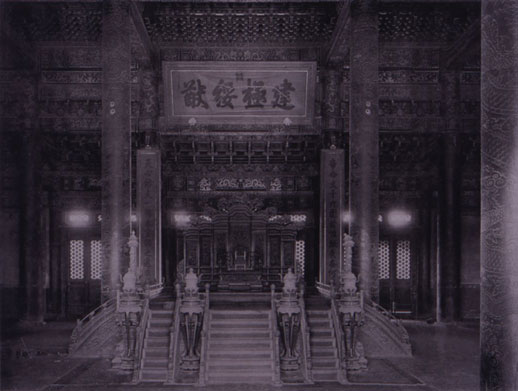Revealing what the Internet cannot
For those who come to Japan from afar, a trip to Beijing may seem a simple short hop away, but let us not forget that travelling is still a luxury for most and more often than not, hindered by a lack of funds. Such a scenario has changed little since the dawn of sightseeing, so it’s no surprise that with the inception of photography in the 19th century and now the Internet and programs such as Google Earth, these once distant lands can be viewed and even experienced with little or no budget. Therefore, we need to look at this exhibition at the Tokyo Metropolitan Museum of Photography as exactly what it is: a window onto something that some of us may never see in person. If we look at it like this, we can begin to see many smaller windows within that window and from this point, the exhibition has us.

The first significant ‘window’ offers a comparative view. Brought to us by the photographs of Hou Yuanchao, these pictures document the ‘Forbidden City’ as it is now, but instead of taking the same views as probably countless numbers of tourists, he has chosen a guided path, replicating the views in the work of Japanese photographer Kazumasa Ogawa, which are shown alongside. During his visit to the city in 1900, Ogawa documented the city and its palace with impeccable clarity at a time when it was off-limits to common people. His mission was not one of inspiration sparked by a particular location but a quest for information, and he would also place people in his images so as to demonstrate a sense of scale. These were technical images in their purest form and their inclusion in the exhibition forms the second ‘window’ onto the famous city.
The third significant ‘window’ is arguably the most educational but its inclusion perhaps the most disappointing. Computer-generated video is generally considered to be the most visual and enlightening way of modelling the past, but in comparison to the other two “windows” which display evidence of their physicality (the age of the prints) and conception (the direct comparison to original compositions), it feels rather shallow, showing only its final form and nothing of its process.

As unrewarding an addition the video is, however, Hou’s photographs are also, at times, equally concerning. The comparative view is useful in that it documents a change in cultural values, and the hoards of tourists roaming the recent pictures illustrate this. However Hou’s decision to photograph the city from the same points of view as Ogawa also presents a struggle against artistic licence. In Ogawa’s picture of one of The Four Main Pillars in the T’ai-hê Hall, a tour guide is trying to extend his arms around the pillar to demonstrate its thickness; and in Hou’s photograph from the same position, someone is likewise hugging the pillar. Why recreate that act? Is he suggesting that we need to make sure that this is still the same building, albeit at least in scale? Why then, in other retaken pictures, has he chosen to ignore Ogawa’s composition? For example, in Ogawa’s picture of the The Mirror in the Ch’ien-ch’ing Hall, one of the mirrors was photographed from an angle, presumably to avoid taking his reflection. Yet Hou has turned the camera to face the mirror directly, showing not only the camera but also an infinite reflection, which begs the question why.
So, whereas Hou’s pictures seem to ask as many questions as they answer (perhaps the answers exist in the oddly unavailable English information), the most informative ‘window’ into this Forbidden City is by far the oldest one presented and this will ensure that it receives its fair share of visitors. In fact, Ogawa’s prints alone are worth a visit to the exhibition and should win any comparisons with online experiences hands-down. Google Earth may bring us close to the Forbidden Palace, but Ogawa’s pictures bring us closer. Despite attempts, they are not easily replicated and the experiences embedded into the physical surface of these old prints certainly cannot either.
Gary McLeod
Gary McLeod


